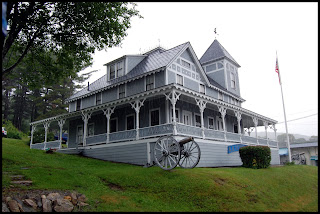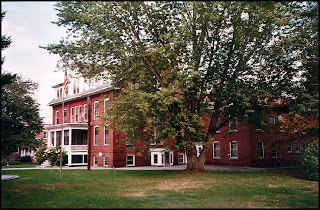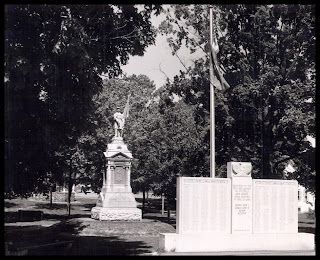“Old Home Week in New Hampshire will be celebrated August 11th to August 18th, 1900, and it gives me unqualified pleasure to invite all absent sons and daughters of the State and all who have some time lived within its borders, to return during that week and assist us in kindling the fires of State patriotism. The busy cities, the thriving villages, the little towns and hamlets among our smiling hills, will receive our visitors with genuine New Hampshire hospitality. The custom of observing Old Home Week was inaugurated last year with complete success . . .
. . . That Old Home Week appealed to the highest sentiments and aroused feelings long dormant was shown by hundreds of poems, sonnets, songs, and marches dedicated to our State, by historical addresses and articles of interest and value, and by orations of great ability. The endowment of libraries, the erection of public buildings, the awakened interest in village improvement and better highways, the repurchasing of the old homesteads and farms, afford proof that the festival also appealed to the practical side of men’s natures. . .”
Governor Frank Rollins. 1900. Invitation to Old Home Week.
The physical, cultural, demographic and economic landscape of New Hampshire changed in the years and decades after the Civil War. The veterans who came home in 1865 returned to a place of transformation that would intensify dramatically by the turn of the 20th century. How did these changes shape the state and how did New Hampshire respond to them?
 |
| Old Home Day, Stoddard. Eighteen Civil War veterans attended the dedication of the Soldiers' Monument on August 24, 1917. Photo courtesy of Stoddard Historical Society, Stoddard, New Hampshire. |
Agricultural New Hampshire succumbed to the pressures and opportunities that the post-war years presented, seeing a decline of the traditional agricultural economy, the availability of cheap or free lands in the West through the Homestead Act of 1862, and expanded exposure and easier access to places beyond New Hampshire and New England. Contributing to the 2% decrease in New Hampshire’s population between 1860 and 1870, in addition to the thousands lost in the war, was the emigration of veterans and others to other parts of the country. Within the state’s borders, population shifts also depleted rural towns of their residents and, along with foreign immigration, contributed to the rapid growth of manufacturing cities.
New Hampshire’s farmers left behind fields and farmsteads as agrarian life declined, resulting in an abundance of abandoned properties, shrinking villages, and the re-forestation of previously cleared pastures and fields.
 |
| “A logging camp, Concord, New Hampshire,” ca. 1925, stereo, Keystone View Company. Image from Library of Congress, Prints & Photographs. |
While railroads had been moving people and goods around New Hampshire and the nation in the decades before the Civil War, it was in the years after the war that their construction boom transformed the state. Miles of railroad track increased 29%, from 661 to 934 between 1861 and 1875 and continued to increase in mileage and power through 1900. One outcome of the railroad’s expansion was the development of two seemingly opposite industries: lumber/paper industries and tourism. One industry was bound to clear-cut the state’s natural landscape and the other promoted its scenic enjoyment.
Lumber production tripled in the last decades of the 19th century, supported by regenerated forests on abandoned farms, an 1867 state-mandated sale of public lands, the development of a new process to produce paper, and the expansion of the railroads into northern New Hampshire. By 1890, 831 sawmills were operating in the state. The Berlin Mills Company – begun solely as a sawmill in 1852 and known as Brown Company after 1917 – diversified into pulp and paper production ca. 1890 and functioned as the region’s largest employer for decades.
While the mountains were being clear-cut by the lumber industry, the railroads also opened New Hampshire to an explosion of seasonal tourism. Numerous facilities to house the influx of tourists were constructed, ranging from small boarding houses on farms to grand resort hotels in the mountains and on the ocean. Begun as a small inn attached to an existing farmhouse in Whitefield in 1866, the Mountain View House in the northern White Mountains expanded substantially in size and accommodations between 1872 and 1927. Publicity materials for the inn made note of its proximity to the Concord & Montreal and Maine Central Railroad stations and to a “panorama of lake, hill and forest scenery which is unsurpassed and forms a glorious setting for the grand mountains which encircle the whole” (W.F. Dodge and Son, Proprietors, ca. 1894).
The indignities of abandonment and late 19th century industry on New Hampshire’s towns, villages, rural landscapes, and wilderness spurred multiple creative responses that would, in turn, impact the state through the early 20th century and beyond. The state sponsored two campaigns at the turn of the century, one intended to bring New Hampshire natives back to the state, Old Home Week, and one to encourage the wealthy to purchase abandoned farms and convert them into summer estates, as promoted in the publication New Hampshire Farms to Summer Homes.
Governor Frank Rollins initiated Old Home Week in 1899 as a way to remember, celebrate and promote the positive aspects of life in New Hampshire and to encourage former residents and their descendants to return to their native towns and reinvest in them on an annual, seasonal or permanent basis. Today, as much as it brings together old neighbors, friends and family, the occasion is a celebration of the places and spaces that make New Hampshire’s communities special. Old Home Week/Day was enthusiastically supported that first year and still remains a celebration observed in communities throughout the state.
Opportunities and progress transformed New Hampshire in the decades after the Civil War. In many respects, the industries and initiatives that encouraged celebration, enjoyment, conservation and preservation of New Hampshire’s landscape and “sense of place” were those that were most successful in the long term. Now, more than a hundred years later, although railroads and many industries have now waned, tourism remains one of the state’s most important economic drivers.
Sources
Ashjian, Cristina, “Kona Farm,” New Hampshire Individual Inventory Form, 2010. In the collection of the New Hampshire Division of Historical Resources, Concord, NH.
Heffernan, Nancy Coffer and Ann Page Stecker. New Hampshire: Crosscurrents in its Development. Lebanon, NH: University Press of New England, 2004.
Hengen, Elizabeth Durfee, “Mountain View House,” National Register of Historic Places Registration Form, 2004. In the collection of the New Hampshire Division of Historical Resources, Concord, NH.
“History of Stoddard’s Old Home Days,” http://www.stoddardnh.org/history/history-stoddards-old-home-days, accessed May 29, 2012.
Inherit New Hampshire, Inc. Old Home Day in New Hampshire 1899-1998: Celebrating the Living Heritage of New Hampshire’s Communities. Concord, NH: Inherit New Hampshire, Inc., 1998.
Inherit New Hampshire, Inc. Old Home Day in New Hampshire 1899-1998: Celebrating the Living Heritage of New Hampshire’s Communities. Concord, NH: Inherit New Hampshire, Inc., 1998.
Mausolf, Lisa, “Brown Company Research & Development Buildings,” New Hampshire Historic Property Documentation NH State No. 646, 2010. In the collection of the New Hampshire Division of Historical Resources, Concord, NH.
http://www.nh.gov/oep/programs/DataCenter/Population/1830-920.htm, accessed April 23, 2012.
Ober, Richard, ed., At What Cost? Shaping the Land We Call New Hampshire: A Land Use History. Concord, NH: New Hampshire Historical Society and Society for the Protection of New Hampshire Forests, 1992.
Rollins, Governor Frank W. Old Home Week Addresses. Concord, NH: Rumford Press, 1900. http://books.google.com/books/reader?id=VH5JAAAAYAAJ&printsec=frontcover&output=reader&source=gbs_atb_hover, accessed May 21, 2012.
Wallace, R. Stuart and Lisa B. Mausolf, “New Hampshire Railroads: Historic Context Statement,” 2001. In the collection of the New Hampshire Division of Historical Resources, Concord, NH.
W.F. Dodge and Son, Proprietors, “Mountain View House, Whitefield, N.H.,” promotional pamphlet, ca. 1894, copy in the collection of the New Hampshire Division of Historical Resources, Concord, NH



























